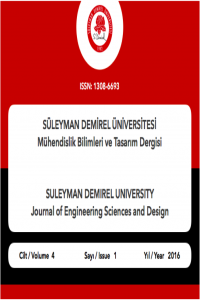Öz
Matlog is a collection of computational routines and data that can be used within Matlab to implement a variety of different logistics-engineering-related tasks and provides a means to script the pre- and post-processing needed to interface with solvers like CPLEX. A detailed example of the use of Matlog to solve a facility location and allocation problem is presented and the use of Matlog in an educational environment is discussed. Matlog is a collection of computational routines and data that can be used within Matlab to implement a variety of different logistics-engineering-related tasks. It consists of Matlab functions that either directly implement solution techniques or provide a means to script the pre- and post-processing needed to interface with solvers like CPLEX. It provides a uniform, platform-independent environment and is available for download at Kay (2015). The routines in Matlog can be grouped into the following categories
Anahtar Kelimeler
Matlog Matlab Facility Location Freight Transport Vehicle Routing Networks
Kaynakça
- Campbell, A., Goentzel, J., Savelsbergh, M. (2000), “Experiences with the use of supply chain management software in education,” Production and Operations Management, Vol. 9, No. 1, pp. 66–80.
- L. Cooper, L. (1963), “Location-allocation problems,” Operations Research, Vol. 11, pp. 331–343.
- Daskin, M. (1995), Network and Discrete Location: Models, Algorithms, and Applications, Wiley, New York. Kay, M. (2015), “Matlog: Logistics Engineering Matlab Toolbox,” http://www.ise.ncsu.edu/kay/matlog (last accessed on July 9, 2015).
- Funaki, K. (2009), “State of the Art Survey of Commercial Software for Supply Chain Design,” Supply Chain and Logistics Institute, Georgia Tech, https://www.scl.gatech.edu/downloads/
- GTSCL_SCDesign_Software_Survey.pdf (last accessed on July 9, 2015).
Öz
Matlog is a collection of computational routines and data that can be used within Matlab to implement a variety of different logistics-engineering-related tasks and provides a means to script the pre- and post-processing needed to interface with solvers like CPLEX. A detailed example of the use of Matlog to solve a facility location and allocation problem is presented and the use of Matlog in an educational environment is discussed. Matlog is a collection of computational routines and data that can be used within Matlab to implement a variety of different logistics-engineering-related tasks. It consists of Matlab functions that either directly implement solution techniques or provide a means to script the pre- and post-processing needed to interface with solvers like CPLEX. It provides a uniform, platform-independent environment and is available for download at Kay (2015). The routines in Matlog can be grouped into the following categories
Anahtar Kelimeler
Kaynakça
- Campbell, A., Goentzel, J., Savelsbergh, M. (2000), “Experiences with the use of supply chain management software in education,” Production and Operations Management, Vol. 9, No. 1, pp. 66–80.
- L. Cooper, L. (1963), “Location-allocation problems,” Operations Research, Vol. 11, pp. 331–343.
- Daskin, M. (1995), Network and Discrete Location: Models, Algorithms, and Applications, Wiley, New York. Kay, M. (2015), “Matlog: Logistics Engineering Matlab Toolbox,” http://www.ise.ncsu.edu/kay/matlog (last accessed on July 9, 2015).
- Funaki, K. (2009), “State of the Art Survey of Commercial Software for Supply Chain Design,” Supply Chain and Logistics Institute, Georgia Tech, https://www.scl.gatech.edu/downloads/
- GTSCL_SCDesign_Software_Survey.pdf (last accessed on July 9, 2015).
Ayrıntılar
| Birincil Dil | İngilizce |
|---|---|
| Konular | Mühendislik |
| Bölüm | Araştırma Makaleleri \ Research Articles |
| Yazarlar | |
| Yayımlanma Tarihi | 28 Nisan 2016 |
| Gönderilme Tarihi | 17 Kasım 2015 |
| Yayımlandığı Sayı | Yıl 2016 Cilt: 4 Sayı: 1 |

